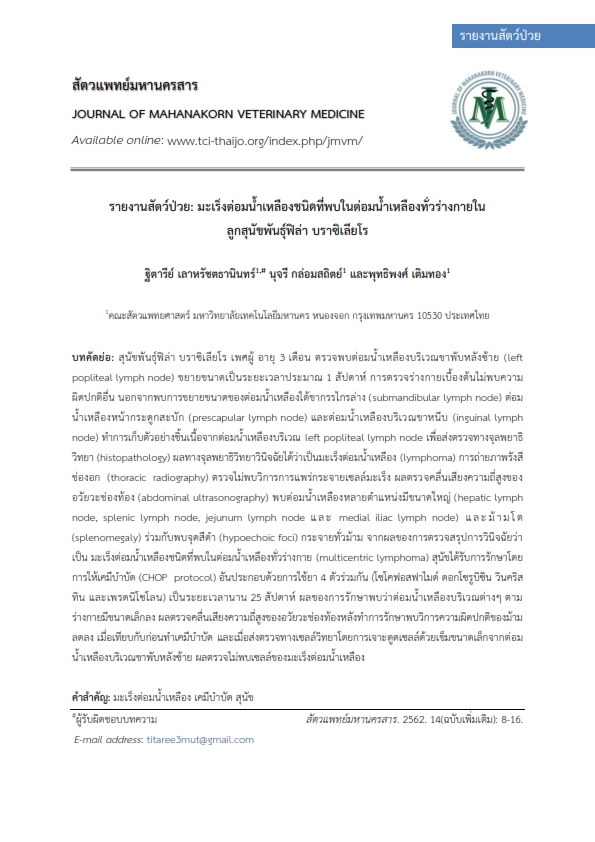Multicentric Lymphoma in Fila Brasileiro Puppy: A Case Report
Main Article Content
Abstract
A 3-month-old male Fila Brasileiro breed, presented with an enlargement of the popliteal lymph node for 1 week. Overall results from the general physical examination were normal except an enlargement of the submandibular, prescapular and inguinal lymph nodes. A biopsy of the popliteal lymph node was performed and lymphoma was diagnosed. A thoracic radiograph did not find evidence of lung metastasis; however the abdominal ultrasound found an enlargement of abdominal lymph nodes (hepatic lymph node, splenic lymph node, jejunum lymph node and medial iliac lymph node). Splenomegaly and diffuse multiple hypo echoic foci in splenic parenchyma were also found from the abdominal ultrasonography. Multicentric lymphoma was diagnosed. The dog was prescribed with a chemotherapy (CHOP protocol), which included the combination of 4 chemotherapeutic agents (cyclophosphamide, doxorubicin, vincristine and prednisolone) for a 25 week treatment duration. The results after chemotherapy showed the lymph nodes decreased in size and an abdominal ultrasound showed the improvement of the lesion in splenic parenchyma when compared to pre chemotherapy. In addition, cytology’s result from fine needle aspiration of popliteal lymph node was also negative from cancer cells after treatment.
Article Details
References
Edwards, D. S., W. E. Henley, E. F. Harding, J. M. Dobson, and J. L. Wood. 2003. Breed incidence of lymphoma in a UK population of insured dogs. Vet. Comp. Oncol. 1(4): 200-206.
Ettinger, S. J. 2003. Principles of treatment for feline lymphoma. Clin. Tech. Small Anim. Pract. 18(2): 98-102.
Ettinger, S. J., E. C. Feldman, and E. Cote. 2017. Textbook of Veterinary Internal Medicine, 8th Edition. Elsevier. Missouri. 5000-5011p.
Fan, T. M. and B. E. Kitchell. 2002 An update on diagnosing and treating canine lymphosarcoma. Veterinary Medicine. 97(1): 58-67.
Garrett, L. D., D. H. Thamm, R. Chun, R. Dudley, and D. M. Vail. 2002. Evaluation of a 6 month chemotherapy protocol with no maintenance therapy for dogs with lymphoma. J Vet Intern Med. 16(6): 704-709.
Jagielski, D., R. Lechowski, J. M. Hoffmann, and S. Winiarczyk. 2002. A retrospective study of the incidence and prognostic factors of multicentric lymphoma in dogs (1998-2000). J. vet. med. 49(8): 419-424.
Marconato, L., M. E. Gelain, and S. Comazzi. 2013. The dog as a possible animal model for human non-Hodgkin lymphoma: a review. Hematol. Oncol. 31(1): 1-9.
Moore, A. S. and A. E. Frimberger. 2010. Oncology for Veterinary Technicians and Nurses. Blackwell Publishing. USA. 229-235p.
Morrison, W. B. 2004. Lymphoma in Dogs and Cats. CRC Press. Wyoming. 3-68p.
Nelson, R. W. and C. G. Couto. 1998. Small animal internal medicine. 2nd ed. Mosby. St. Louis. 1123–1133p.
Owen, L. N. 1980. TNM classification of tumors of domestic animals. 1st ed. World Health Organization, Geneva. 46-47.
Rallis, T., A. Koutinas, and S. Lekkas. 1992. Lymphoma (malignant lymphoma, lymphosarcoma) in the dog. J. Small Anim. Pract. 33(12): 590–596.
Vail D. M. 1995. Treatment and prognosis of canine malignant lymphoma. In: Bonagura JD, Kirk RW. Kirk’s current veterinary therapy XII small animal practice. WB Saunders. Philadelphia. 494-497p.
Vail. D. M., E. G. MacEwen, and K. M. Young. 2001. Canine lymphoma and lymphoid leukemias. In: Withrow S. J., E. G. MacEwen, editors. Small animal clinical oncology. 3rd ed. WB Saunders. Philadelphia. 558–580p.
Villamil, J. A., C. J. Henry, A. W. Hahn, J. N. Bryan, J. W. Tyler, and C. W. Caldwell. 2009. Hormonal and sex impact on the epidemiology of canine lymphoma. J. Cancer Epidem. 2009: 591753.
Withrow, S. J., D. M. Vail, and R. L. Page. 2013. Withrow & MacEwen’s small animal clinical oncology. 5th ed. WB Saunders. St. Louis. 699-732p.


